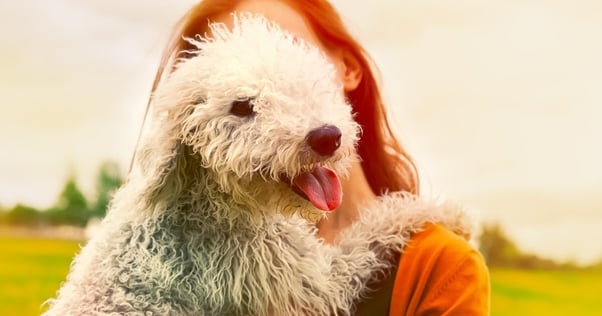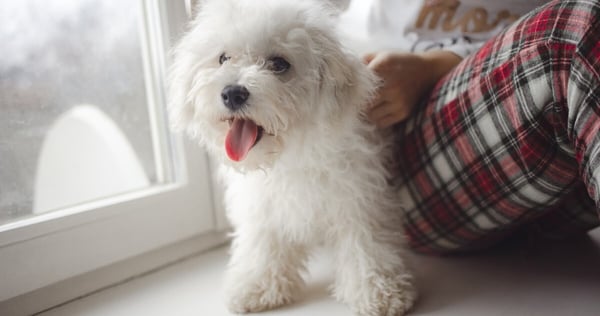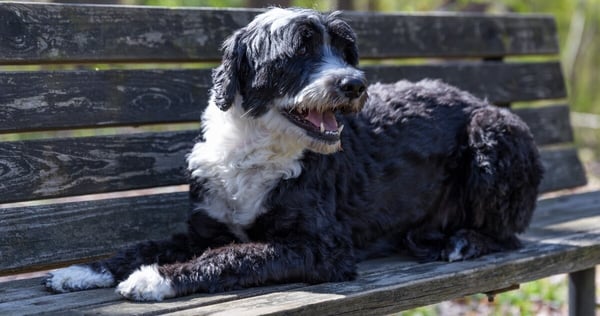Are you an allergy sufferer but very keen to have a canine companion? Did you know that more than 600 million people worldwide suffer from allergic rhinitis (commonly known as hay fever when it is triggered by seasonal pollens) and this can be triggered by dust, grass or tree pollen, as well as our pets?
If you’re affected by this, did you know that it’s not the dog hair we become allergic to, but the dander protein (tiny specks of skin) which is present, and shed, by pets. This protein can also be found in canine saliva and urine (so dogs that drool a lot may trigger your allergies too).
So what can you do if you have allergies but would love to care for a cute dog? Luckily there are breeds that are less likely to cause a reaction!
Be aware - there is always a chance of allergy
Although there are many non-shedding dog breeds that are very popular with allergy sufferers, remember that no dog is 100% hypoallergenic and, as all dogs are individual, some will naturally produce less of the protein than others.
We shouldn’t let this stop us living our dream and realizing the joys of having a dog in our home. If you're thinking about getting your first pooch, take a look at what dog breeds are best for first time dog owners. There are many ways that you can minimize your allergies, but firstly let’s explore some dog breeds that are generally more appropriate for allergy sufferers.
SOME DOG BREEDS THAT ARE IDEAL FOR ALLERGY SUFFERERS
The Bedlington Terrier

This cute terrier could almost be mistaken for a lamb! But as a no-shedding, lively, and loyal companion, the Bedlington Terrier is full of fun and likes being the center of attention.
The Bichon Frise

A playful and naturally gentle dog that loves activity. Although their hair doesn’t shed, it does continually grow, so regular grooming is important to prevent it matting.
The Coton de Tulear
Although this cute breed has long hair, it doesn’t shed much. A relative of the Bichon Frise, their personalities tend to be great with families. Although their “cotton” like coats do not shed a lot, they do need daily brushing to prevent matting which could be an issue for someone with allergies.
The Poodle
Poodles have a soft curly coat which doesn’t shed much and is a popular breed for those that suffer from allergic rhinitis. However, they should be groomed regularly to stop their coat from getting tangled and keep them in tip top condition; you may find it easier to use a professional groomer regularly to help keep their coat in the best condition.
Poodle mix Breeds
From Cockapoos, to Labradoodles, a Cavapoo, a Maltipoo and even a Bernedoodle, you should not assume that you will not react to them just because they are mixed with a Poodle! Poodle puppies will take traits from both parents, and like humans their genes will be mixed; some may take more of their genes from their non-Poodle parent, making that particular pooch produce more of the allergen or shed more. So, if you are considering adopting a Poodle mix breed, make sure you spend plenty of time with them first to make sure no allergies are triggered.
Portuguese Water Dog

Despite having a thick waterproof coat, the Portuguese Water Dog sheds very little hair and they are not droolers, which makes them a great choice for allergy sufferers. They are also easy to train, have lots of energy and love to play. This is also one of the breeds of dog that has webbed feet!
HOW TO MINIMIzE ALLERGIES FROM DOGS
How allergenic a dog is depends on the individual dog, but there are also things you can do to keep the dog dander at bay.
- Think about the size of dog you are going to adopt; it follows that a larger dog will create more dander allergens than a small dog, simply because they have more hair!
- Regularly clean soft furnishings around the home which may attract dog hair.
- Hard flooring is a good choice of flooring as it is easier to remove any hair/dander, than from carpets. Wash the floor regularly.
- Use a vacuum cleaner with a HEPA filter to help remove the majority of allergens. A robotic vacuum cleaner which wanders around the house on its own, could help to keep dog hair and dander under control - and save you a chore!
- Make sure you bathe your dog regularly; you may want to check with your vet about the best shampoo to use that will avoid dry skin on your pooch.
- Wash your doggo’s bedding regularly to avoid excessive build up and minimize the amount of airborne allergens.
- Delegate dog brushing/grooming to someone who does not have an allergy. If you’re taking your dog to a groomer, using an ADAPTIL Calm On-The-Go Collar can help keep them calm throughout the drive and grooming session. If bushing your pooch yourself, do it outdoors when possible to reduce the allergens in your home.
- If you have been out walking in the fields with your dog, make sure they are brushed well or wiped down with a damp cloth when they get home, to remove any pollen or other allergens that they will pick up as they run around.
- Establish ‘dog free’ areas in your home; train your dog that they are not allowed upstairs or in the bedroom, for example, to reduce the areas that may trigger your allergies.
- Change your clothes after you’ve had a lot of close contact with your dog, for example socialization classes, or playtime.
Have you noticed that your dog seems to shed more hair in the car? Some dogs shed more hair, and therefore dander, into the environment when they are anxious or nervous which could, in turn, enhance your allergic symptoms. To help keep your dog calm and provide a feeling of security, use an ADAPTIL Calm Home Diffuser, permanently plugged in to provide constant comfort for your dog.


